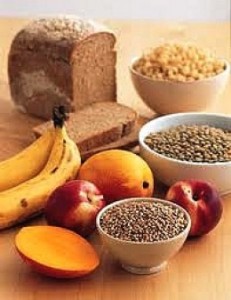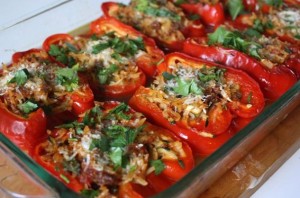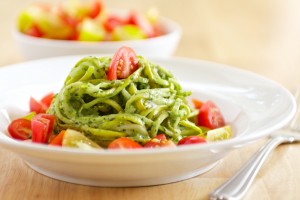 In recognition of National Diabetes Month, we’re here to offer you tips and tricks to manage diabetes, as well as healthy recipes to coincide with a balanced, diabetes friendly diet. But before we start with all of that, what IS diabetes? There are several types of diabetes, Type 1 Diabetes, Type 2 Diabetes, Late Adult Onset Diabetes, and Gestational Diabetes. In Type I Diabetes, a hormone called insulin, which normally helps to maintain blood sugar levels in the body is not produced; whereas in Type II Diabetes, insulin is still produced, however it is not working properly, a condition that is known as decreased insulin sensitivity or insulin resistance. However, Type II Diabetes can sometimes be reversed or controlled with weight loss, a healthy diet and lifestyle changes! Living with Diabetes is certainly manageable as well, as long as you are mindful of food choices. Check out our diabetes page for more information. To see if you are at risk for diabetes take this test.
In recognition of National Diabetes Month, we’re here to offer you tips and tricks to manage diabetes, as well as healthy recipes to coincide with a balanced, diabetes friendly diet. But before we start with all of that, what IS diabetes? There are several types of diabetes, Type 1 Diabetes, Type 2 Diabetes, Late Adult Onset Diabetes, and Gestational Diabetes. In Type I Diabetes, a hormone called insulin, which normally helps to maintain blood sugar levels in the body is not produced; whereas in Type II Diabetes, insulin is still produced, however it is not working properly, a condition that is known as decreased insulin sensitivity or insulin resistance. However, Type II Diabetes can sometimes be reversed or controlled with weight loss, a healthy diet and lifestyle changes! Living with Diabetes is certainly manageable as well, as long as you are mindful of food choices. Check out our diabetes page for more information. To see if you are at risk for diabetes take this test.
An A1C blood level can be used to screen for diabetes and for monitoring diabetes treatments. It is a 2-3 month estimated average glucose or blood sugar. Knowing your numbers is important and you can follow trends in your average blood sugar. All adults age 45 and older should regularly be screened for diabetes and those younger with symptoms or risk factors.
According to the American Diabetes Association, carbohydrate counting or carb counting is the main way to help control Diabetes.  Controlling your carbohydrate intake per meal can greatly reduce the post-meal spike in glucose. Everyone’s body is different, but around 45-60 grams per meal and 15-30 grams per snack is a good place to start. Very active adults or younger men may need more. Use this as your baseline value, and adjust as needed depending on your physical activity level and any medications that you might be taking to control blood sugar levels. We can help you determine your specific carbohydrate needs. Just as a reference, 15 grams of carbohydrates looks like one small piece of fruit, 1 slice of bread, ¼ of a large baked potato, or 1 tablespoon of syrup, jam, or jelly. Calorie King is a great resource to learn the carbohydrate counts of various foods. Once you’ve got the carb counting basics down, being aware of varying glycemic indexes in foods can help to further meet blood sugar goals.
Controlling your carbohydrate intake per meal can greatly reduce the post-meal spike in glucose. Everyone’s body is different, but around 45-60 grams per meal and 15-30 grams per snack is a good place to start. Very active adults or younger men may need more. Use this as your baseline value, and adjust as needed depending on your physical activity level and any medications that you might be taking to control blood sugar levels. We can help you determine your specific carbohydrate needs. Just as a reference, 15 grams of carbohydrates looks like one small piece of fruit, 1 slice of bread, ¼ of a large baked potato, or 1 tablespoon of syrup, jam, or jelly. Calorie King is a great resource to learn the carbohydrate counts of various foods. Once you’ve got the carb counting basics down, being aware of varying glycemic indexes in foods can help to further meet blood sugar goals.
 In order to keep your blood sugar levels stable, it is crucial to know which foods raise glucose levels more so than others, having a higher glycemic index. High glycemic foods include white breads, sugar sweetened beverages, candy, etc. On the other hand, foods made with whole grains such as whole grain breads and pastas, oatmeal, and air popped popcorn are better choices in terms of limiting the glucose spike post-meal. Some ways to introduce these lower glycemic index foods into your diet are to mix half of your regular pasta with whole grain pasta and gradually increase the amount of whole grains until you’ve completely replaced the white pasta. Additionally, some vegetables can be used as pasta! For example, spaghetti squash has a similar texture to spaghetti noodles, and a lower glycemic index, as well as zucchini that can be peeled with a spiral slicer to mimic the texture of pasta. All of these options will also simultaneously increase your fiber intake, which has also been shown to be effective in stabilizing blood sugar levels.
In order to keep your blood sugar levels stable, it is crucial to know which foods raise glucose levels more so than others, having a higher glycemic index. High glycemic foods include white breads, sugar sweetened beverages, candy, etc. On the other hand, foods made with whole grains such as whole grain breads and pastas, oatmeal, and air popped popcorn are better choices in terms of limiting the glucose spike post-meal. Some ways to introduce these lower glycemic index foods into your diet are to mix half of your regular pasta with whole grain pasta and gradually increase the amount of whole grains until you’ve completely replaced the white pasta. Additionally, some vegetables can be used as pasta! For example, spaghetti squash has a similar texture to spaghetti noodles, and a lower glycemic index, as well as zucchini that can be peeled with a spiral slicer to mimic the texture of pasta. All of these options will also simultaneously increase your fiber intake, which has also been shown to be effective in stabilizing blood sugar levels.
Eating smaller, more frequent meals can help control high levels of glucose by keeping your blood sugars stable throughout the day as opposed to constant ebbs and flows. And as always, an overall balanced diet helps to prevent the dreaded glucose spike after eating a meal. Once you’ve got your shopping list down, make sure you’re able to create proper portion sizes for each meal as well! Remember also to know your numbers and get your regular health screenings. Check out our blog for other diabetes related posts.
So now, let’s get to the fun stuff! See below for some healthy diabetes-friendly recipes.
Taco Stuffed Peppers
Nutrition Information Per Serving (1/2 green pepper + filling):
Calories: 195
Fat: 3 g
Carbohydrates: 4 g
Fiber: 0 g
Protein: 19 g
Sugars: 1g
Sodium: 273 mg
Ingredients
2 large green peppers, halved lengthwise + seeded
1 pound lean ground turkey
1 tablespoon less sodium taco seasoning
¼ cup tomato salsa
¼ cup Reduced Fat Sharp Cheddar Shredded Cheese
Optional toppings:
diced tomatoes
diced avocado
hot sauce
Whole Grain Brown Rice
Instructions
Preheat oven to 350º F.
Brown ground turkey in a large skillet on medium heat.
Add 1 tablespoon of water and the seasoning to the turkey and stir.Add salsa. If meat seems too dry, add a little more. Turn heat to low when turkey is heated thoroughly.
Add cheese and mix well.
Cut green peppers in half, top to bottom. Cut a semi-circle around the stem and remove the stem and seeds in one cut. Or leave the stems on like in the photo, up to you!
Repeat until you have four halves.
Place halves two at a time in boiling water for 3-5 minutes. The “skin” will lose a little brightness after the cook. (Beware, the peppers are slippery- tongs are helpful!)
Place peppers in a baking dish open side up and fill with your meat mixture.
Bake in the oven for 20-25 minutes.
Place on plates and sprinkle with the toppings of your choice.
 Spiralized Zucchini Noodles with Tomatoes and Pesto
Spiralized Zucchini Noodles with Tomatoes and Pesto
Via skinnytaste.com
Servings: 4, Serving Size: 1 1/4 cups
Calories: 148
Fat: 12 g
Carbohydrates: 9 g
Fiber: 3 g
Protein: 4 g
Sugar: 3 g
Sodium: 102 mg (without salt)
Ingredients
For the Pesto:
1 cup packed fresh basil
1 clove garlic
1/4 cup fresh grated parmesan cheese
kosher salt & pepper to taste
3 tbsp extra virgin olive oil
For the zoodles:
21 oz (3 medium or 4 small) zucchinis
1 cup heirloom grape or cherry tomatoes, halved
Kosher salt and black pepper to taste
Directions
In a food processor pulse basil, garlic, parmesan cheese, salt and pepper until smooth. Slowly add the olive oil while pulsing. Set aside.
Spiralize the zucchini, cut it into smaller strands if they are too long and place them in a work bowl. Toss with the pesto and tomatoes and season with salt and pepper as needed.
Enjoy,
Kellsey O’Donnell
Eat Fit Health Intern
Graduate Student, Drexel University
MS in Human Nutrition, 2016